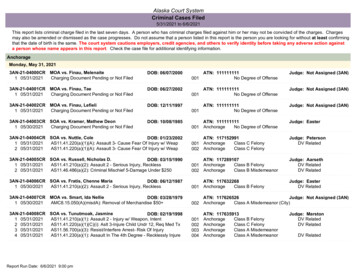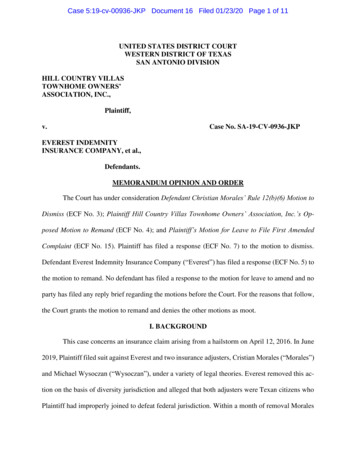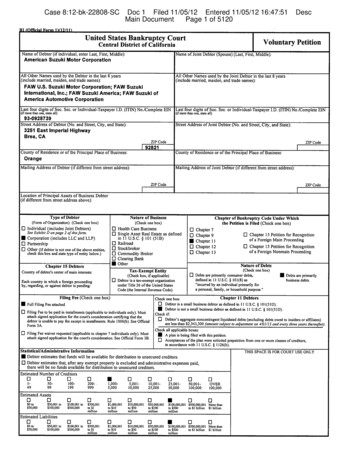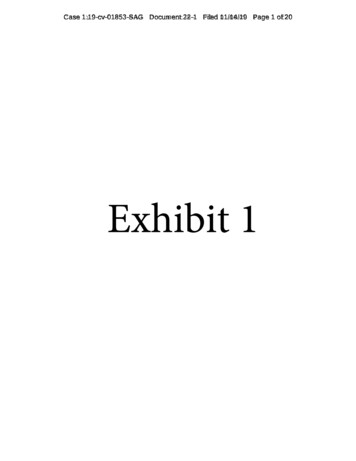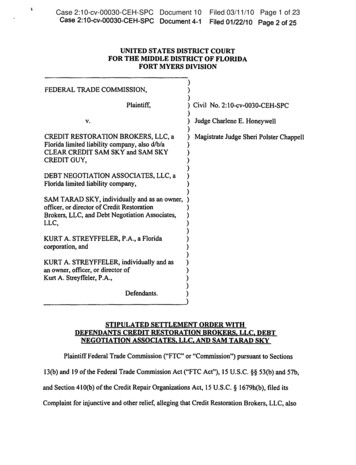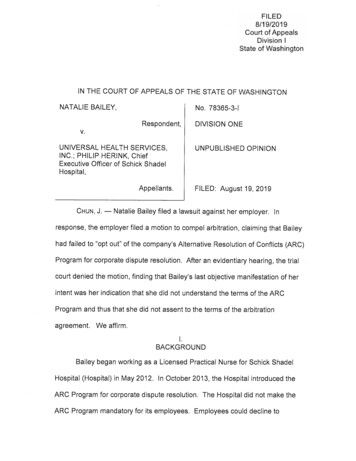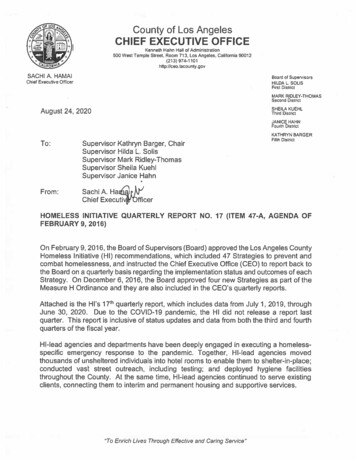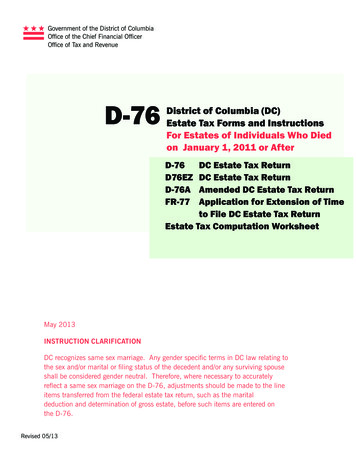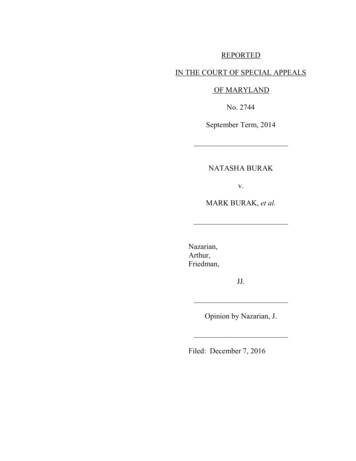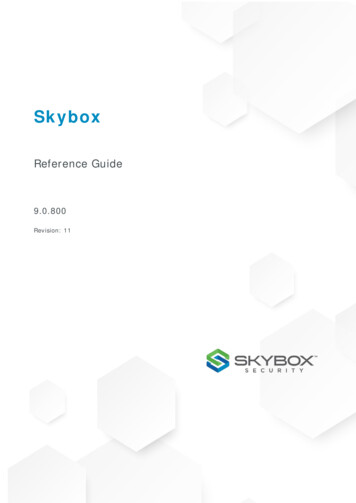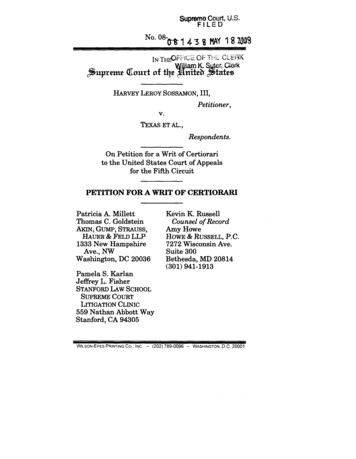
Transcription
Supreme Court, U.S.FILED 80 143 t I q’ ; u reme ourt of t [nit tate HARVEY LEROY SOSSAMON, III,Petitioner,Respondents.On Petition for a Writ of Certiorarito the United States Court of Appealsfor the Fifth CircuitPETITION FOR A WRIT OF CERTIORARIKevin K. RussellCounsel of RecordAmy HoweHowe & RUSSELL, P.C.7272 Wisconsin Ave.Suite 300Bethesda, MD 20814(301) 941-1913Patricia A. MillettThomas C. GoldsteinAKIN, GUMP, STRAUSS,HAUER ELD LLP1333 New HampshireAve., NWWashington, DC 20036Pamela S. KarlanJeffrey L. FisherSTANFORD LAW SCHOOLSUPREME COURTLITIGATION CLINIC559 Nathan Abbott WayStanford, CA 94305WILSON-EPES PRINTING Co., INC. -(202) 789-0096 -WASHINGTON, D.C. 20001
lank Page
QUESTION PRESENTEDThe Religious Land Use and InstitutionalizedPersons Act, 42 U.S.C. §§2000cc to 2000cc-5,provides an express private right of action to "obtainappropriate relief against a government," id.§ 2000cc-2. The statute defines "government" toinclude state and local governmental entities and any"official of [such] an entity." Id. § 2000cc-5(4) (A).The Fifth Circuit held, in conflict with the decisionsof other courts, that the Constitution prohibitsCongress from authorizing damages claims againststates, or against state officials in their individual orpersonal capacities, for violations of the statute. Thequestion presented is:Whether states and state officials may besubject to suit for damages for violations of theReligious Land Use and Institutionalized PersonsAct?
iiPARTIES TO THE PROCEEDINGSPetitioner is Harvey Leroy Sossamon, III, aninmate in the Robertson Unit of the TexasDepartment of Criminal Justice.Respondents are the State of Texas; ChristinaMelton Crain, Chair, Texas Criminal Justice Board;Cathy Clement, Assistant Director, TexasDepartment of Criminal Justice, CorrectionalInstitution Division Region VI; Brad Livingston,Executive Director, Texas Department of CriminalJustice; Doug Dretke, Executive Director,Correctional Institlational Division; Reverend R.G.Murphy, Texas Department of Criminal Justice,Correctional Institutional Division Region VIChaplaincy Regional Program Admin.; SeniorWarden Robert Eason, French M. Robertson Unit,Texas Department of Criminal Justice, CorrectionalInstitutional Division; Assistant Warden Stacy L.Jackson, French M. Robertson Unit, TexasDepartment of Criminal Justice, CorrectionalInstitutional Division; Chaplain Paul J. Klien,French M. Robert,, on Unit, Texas Department ofCriminal Justice, Correctional Institutional Division.
iiiTABLE OF CONTENTSQUESTION PRESENTED .iiiPARTIES TO THE PROCEEDINGS .TABLE OF AUTHORITIES .vPETITION FOR A WRIT OF CERTIORARI .1OPINIONS BELOW . 1JURISDICTION .1RELEVANT CONSTITUTIONAL ANDSTATUTORY PROVISIONS .11I. Constitutional Provisions .2II. Statutory Provisions .STATEMENT OF THE CASE .4REASONS FOR GRANTING THE WRIT .11I.Courts Are Divided Over The Availability OfCompensatory Damages Against State12Defendants Under RLUIPA .A. Courts Are Divided Over Whether TheEleventh Amendment Precludes DamagesAwards Under RLUIPA Against StatesAnd State Officials In Their OfficialCapacities .13B. Courts Are Also Divided Over WhetherRULIPA Constitutionally AuthorizesDamages Suits Against State Officials InTheir Individual Capacities .16II. This Court’s Review Is Warranted Both ToResolve The Circuit Conflict And To ReviewThe Fifth Circuit’s Partial Invalidation Of AnAct Of Congress .21
ivA. Review Is Warranted To Resolve TheDivision Of Authority Over TheAvailability Of RLUIPA Damages ClaimsAgainst State Defendants .22B. Review Is Also Warranted Because TheCourt of Appeals Partially Invalidated AnAct Of Congress .25III. Review Is Warranted Because The Court OfAppeals’ Decision Conflicts With TheDecisions Of This Court .26A. The Eleven h Amendment Does Not BarRLUIPA Suits For Damages AgainstStates And State Officials In TheirOfficial Capacities .27B. Congress Did Not Exceed ItsConstitutional Authority By ImposingPersonal Liability On State Officials WhoViolate RLUIPA .32CONCLUSION .37APPENDIXCourt of Appeals Decision .laDistrict Court I: ecision .36a
VTABLE OF AUTHORITIESCasesAgrawal v. Briley,No. 02 C 6807, 2006 WL 3523750(N.D. Ill. Dec. 6, 2006) .18Ahmed v. Furlong,435 F.3d 1196 (10th Cir. 2006) .18Am. Communications Ass’n v. Douds,339 U.S. 382 (1950) .26Antrican v. Odom,290 F.3d 178 (4th Cir. 2002) .20Atascadero State Hosp. v. Scanlon,473 U.S. 234 (1985) .13Barnes v. Gorman,536 U.S. 181 (2002) . passimBennett v. Ky. Dep’t of Ed.,470 U.S. 656 (1985) .33Benning v. Georgia,129 Fed. Appx. 603 (11th Cir. 2005) .22Benning v. Georgia,391 F.3d 1299 (11th Cir. 2004) . 11, 14Blum v. Bacon,457 U.S. 132 (1982) .33Boles v. Neet,402 F. Supp. 2d 1237 (D. Colo. 2005) .24Cannon v. Univ. of Chicago,441 U.S. 677 (1979) .28Cardinal v. Metrish,No. 08-1652, 2009 WL 1098759(6th Cir. Apr. 24, 2009) .14, 15, 22, 24
viCarleson v. Remillard,406 U.S. 598 (1972) .33Clinton v. City of New York, 524 U.S. 417 (1998) .26Cromer v. Braman,No. 1:07-cv-009, 2009 WL 806919(W.D. Mich. Mar. 25, 2009) .19Cutter v. Wilkinson,423 F.3d 579 (6th Cir.), rev’d,544 U.S. 709 (2005) .36Cutter v. Wilkinson,544 U.S. 709 (2005) . 5, 23Farnsworth v. Baxter,No. 03-2950-B/V, 2007 WL 2793364(W.D. Tenn. Sept. 26, 2007) .18Figel v. Overton,263 Fed. Appx. 45.6 (6th Cir. 2008) .18Franklin v. Gwinne t County Pub. Schs.,503 U.S. 60 (1992) . 9, 14, 28, 29Garner v. Morales,No. 07-41015, 2009 WL 577755(5th Cir. Mar. 6, 2009) .22Haley v. Donovan,250 Fed. Appx. 202 (9th Cir. 2007) .18Hathcock v. Cohen,287 Fed. Appx. 793 (11th Cir. 2008) .22Kentucky v. Graha ,:,473 U.S. 159 (198.5) . 13Koger v. Bryan,523 F.3d 789 (7th Cir. 2008) .17
viiLane v. Pena,518 U.S. 187 (1996) . 29, 30Lovelace v. Lee,472 F.3d 174 (4th Cir. 2006) .18Madison v. Virginia,474 F.3d 118 (4th Cir. 2006) . passimMayfield v. Tex. Dep’t of Crim. Justice,529 F.3d 59 (5th Cir. 2008) .16McCulloch v. Maryland,17 U.S. (4 Wheat.) 316 (1819) .34Missouri Child Care Ass’n v. Cross,294 F.3d 1034 (8th Cir. 2002) .20Morris-El v. Menei,No. Civ.A. 00-200J, 2006 WL 1455592(W.D. Pa. May 22, 2006) .19Moxley v. Town of Walkersville,601 F. Supp. 2d 648 (D. Md. 2009) .23Nat’l Endowment for the Arts v. Finley,524 U.S. 569 (1998) .26Neder v. United States,527 U.S. 1 (1999) .31New York v. United States,505 U.S. 144 (1992) .34Orafan v. Goord,No. 00CV2022, 2003 WL 21972735(N.D.N.Y. Aug. 11, 2003) .18Pennhurst State Sch. & Hosp. v. Halderman,451 U.S. 1 (1981) .29Pharm. Research & Mfrs. of Am. v. Walsh,538 U.S. 644 (2003) .20
VlllSabri v. United Sta ,es,541 U.S. 600 (2004) . 34, 35Salahuddin v. Goord,467 F.3d 263 (2d Cir. 2006) .18Salinas v. United States,522 U.S. 52 (1997) .26Sefeldeen v. Alameida,238 Fed. Appx. 204 (9th Cir. 2007) .18Seminole Tribe of F ;a. v. Florida,517 U.S. 44 (1996) .26Sisney v. Reisch,533 F. Supp. 2d 952 (D.S.D. 2008),appeal docketed Apr. 22, 2008 .32Smith v. Allen,277 Fed. Appx. 979 (11th Cir. 2008) .22Smith v. Allen,502 F.3d 1255 (11th Cir. 2007) . passimSmithback v. Crain,No. 07-10274, 2009 WL 552227(5th Cir. Mar. 5, 2009) .22Solid Waste Agency v. U.S. Army Corps ofEng’rs, 531 U.S. 159 (2001) .26Townsend v. Swank.404 U.S. 282 (1971) .33United States v. Coombs,37 U.S. 72 (1838) .34United States v. Morgan,230 F.3d 1067 (8th Cir. 2000) .19United States v. Morrison,529 U.S. 598 (2000) .26
ixUnited States v. Stevens,S. Ct. , 2009 WL 1034613 (Apr. 20, 2009) .26Walker v. Iowa Dep’t of Corr.,298 Fed. Appx. 535 (8th Cir. 2008) .18Watts v. Dir. of Corr.,No. CV F-03-5365, 2006 WL 2320524(E.D. Cal. Aug. 10, 2006) .24Westside Mothers v. Haveman,289 F.3d 852 (6th Cir. 2002) .19Statutes18 U.S.C. § 666(a)(2) .3528 U.S.C. § 2403(a) .1242 U.S.C. § 1983 . 6, 1642 U.S.C. § 2000d-7(a) . 32Americans with Disabilities Act,Title II, 42 U.S.C. §§ 12131 to 12165 .2742 U.S.C. § 12133 . 27Civil Rights Act of 1964,Title VI, 42 U.S.C. §§ 2000d to 2000d-7 .27, 29, 30Education Amendments of 1972,Title IX, 20 U.S.C. §§ 1681 to 1688 .9, 28, 29Rehabilitation Act of 1973,29 U.S.C. §§ 701 et seq . 27, 29, 3029 U.S.C. § 794(a) .2929 U.S.C. § 794a .2729 U.S.C. § 794a(a)(2) . 27, 30Religious Land Use and InstitutionalizedPersons Act,42 U.S.C. §§ 2000cc to 2000cc-5 (2000) . passim
x42 U.S.C. § 2000cc . 2342 U.S.C. § 2000cc-1 . 2, 4, 542 U.S.C. § 2000cc-l(a) .442 U.S.C. § 2000cc-l(a)(1) .442 U.S.C. § 2000cc-1(a)(2) .442 U.S.C. § 2000cc-l(b) .442 U.S.C. § 2000cc-l(b)(1) . 542 U.S.C. § 2000cc-2 . 3, 12, 3642 U.S.C. § 2000cc-2(a) . 6, 12, 3642 U.S.C. § 2000cc-2(f) .3142 U.S.C. § 2000cc-3(g) . 3242 U.S.C. § 2000cc-5 . 3, 642 U.S.C. § 2000cc-5(4) . 1242 U.S.C. § 2000cc-5(7)(A) .4U.S. CONST. art. 1, !} 8, cl. 18 .33U.S. CONST. art. I, § 8, cl. 1 . passimOther AuthoritiesSamuel R. Bagenstos, Spending ClauseLitigation in the Roberts Court,58 DUKE L.J. 345 (2008) .21David E. Engdahl, ’he Spending Power,44 DUKE L.J. 1 (1994) .21Richard W. Garnett, The New Federalism, theSpending Power, and Federal Criminal Law,89 CORNELL L. REV. 1 (2003) .21Derek L. Gaubatz, RLUIPA at Four: Evaluatingthe Success and Constitutionality of RLUIPA’sPrisoner Provisions,28 HARV. J.L. & t B. POL’Y 501 (2005) .24
xiH.R. Rep. No. 106-219 (1999) . 5, 36Joint Statement of Senator Hatch and SenatorKennedy on the Religious Land Use andInstitutionalized Persons Act of 2000,5146 Cong. Rec. 7774 (daily ed. July 27, 2000) .Protecting Religious Liberty After Boerne v.Flores: Hearing Before the Subcomm. on theConstitution of the House Comm. on theJudiciary, 105th Cong., 1st Sess., Pt. 3 (1998) .5Frank T. Santoro, Section Five of the FourteenthAmendment and the Religious Land Use andInstitutionalized Persons Act,3624 Whittier L. Rev. 493 (2002) .STERN GRESSMAN, SUPREME COURT PRACTICE(9th ed. 2007) .26Supreme Court Rule 29.4(b) .12
Blank Page
PETITION FOR A WRIT OF CERTIORARIPetitioner Harvey Leroy Sossamon, IIIrespectfully petitions for a writ of certiorari to reviewthe judgment of the United States Court of Appealsfor the Fifth Circuit.OPINIONS BELOWThe opinion of the court of appeals (Pet. App. la35a) is reported at 560 F.3d 316 (5th Cir. 2009). Thedistrict court’s opin]o (Pet. App. 36a-57a) isunpublished.JURISDICTIONThe judgment of the court of appeals was enteredon February 17, 2009. Pet. App. 35a. This Court hasjurisdiction pursuant to 28 U.S.C. § 1254(1).RELEVANT CONSTITUTIONAL ANDSTATUTORY PROVISIONSI.Constitutional ProvisionsThe Eleventh Amendment to the United StatesConstitution, U.S. CONST. amend. XI, provides:The Judicial power of the United States shallnot be construed to extend to any suit in lawor equity, commenced or prosecuted againstone of the United States by Citizens ofanother State, or by Citizens or Subjects ofany Foreign State.The Spending Clause of the United StatesConstitution, U.S. CONST. art. I, § 8, cl. 1, provides, inrelevant part:
The Congress shall have Power To lay andcollect Taxes, Duties, Imposts and Excises, topay the Debts and provide for the commonDefence and general Welfare of the UnitedStates; but all Duties, Imposts and Excisesshall be uniform throughout the UnitedStates .II. Statutory ProvisionsThe Religious Land Use and InstitutionalizedPersons Act, 42 U.S.C. §§ 2000cc to 2000cc-5 (2000),provides, in relevant part:Section 2000cc-1.Protection ofreligious exercise of institutionalizedpersons(a) General ruleNo government shall impose a substantialburden on the religious exercise of a personresiding in or confined to an institution, asdefined in section 1997 of this title, even ifthe burden results from a rule of generalapplicability, unless the governmentdemonstrates that imposition of the burdenon that person -(1) is in furtherance of a compellinggovernment interest; and(2) is the least restrictive means offurthering that compelling interest.(b) Scope of applicationThis section applies in any case in which --
3(1) the substantial burden is imposed in aprogram or activity that receivesFederal financial assistance; or(2) the substantial burden affects, orremoval of that substantial burdenwould affect, commerce with foreignnations, among the several States, orwith Indian tribes.Section 2000cc-2. Judicial relief(a) Cause of actionA person may assert a violation of thischapter as a claim or defense in a judicialproceeding and obtain appropriate reliefagainst a government.Section 2000cc-5. DefinitionsIn this chapter:****(4) GovernmentThe term "government"-(A) means(i) a State, county, municipality, orother governmental entitycreated under the authority of aState;(ii) any branch, department,agency, instrumentality, orofficial of an entity listed inclause (i); and(iii) any other person acting undercolor of State law .
4STATEMENT OF THE CASEPetitioner, a prison inmate, brought this suitagainst the State of Texas and state prison officials intheir individual and of cial capacities, seekingmonetary damages for violations of his rights underthe Religious Land Use and Institutionalized PersonsAct (RLUIPA), 42 U.S.C. §§ 2000cc to 2000cc-5(2000). In acknowledged conflict with the decisions ofother federal courts, the Fifth Circuit held thatalthough RLUIPA’s statutory text supporteddamages claims against states and state officials, theEleventh Amendment and Spending Clauseforeclosed such relief.1. RLUIPA is a civil rights law designed toprotect against religious discrimination, unequalreligious accommodations, and unjustifiedinfringement of the free exercise of religion. Section3 of the Act applies to any state prison that "receivesfederal financial as sistance." id. § 2000cc-l(b), anddirects that "[n]c, government shall impose asubstantial burden on the religious exercise of aperson residing in or confined to an institution," id.§ 2000cc-l(a), unless the burden "is in furtherance ofa compelling gover mental interest" and "is the leastrestrictive means" of furthering that interest, id.§§ 2000cc-1(a)(1) a ad (2). "[R]eligious exercise" isdefined as "any exercise of religion, whether or notcompelled by, or central to, a system of religiousbelief." Id. § 2000cc-5(7)(A).Congress enacted RLUIPA’s institutionalizedpersons provision ir t response to substantial evidencecollected during three years of hearings that personsinstitutionalized in state facilities face "’frivolous or
5arbitrary’ barriers" to their religious exercise. Cutterv. Wilkinson, 544 U.S. 709, 716 (2005) (citationomitted); see also H.R. Rep. No. 106-219, at 9-10(1999) (describing prison’s taping of confessionbetween priest and penitent); Joint Statement ofSenator Hatch and Senator Kennedy on the ReligiousLand Use and Institutionalized Persons Act of 2000,146 Cong. Rec. 7774, 7775 (daily ed. July 27, 2000)(Joint Stmn.) (summarizing findings); ProtectingReligious Liberty After Boerne v. Flores: HearingBefore the Subcomm. on the Constitution of the HouseComm. on the Judiciary, 105th Cong., 1st Sess., Pt. 3,(discussing discriminatoryat 41 (1998)accommodations).Based on its investigation, Congress found that,"[w]hether from indifference, ignorance, bigotry, orlack of resources, some institutions restrict religiousliberty in egregious and unnecessary ways." JointStmn., 146 Cong. Rec. at 7775. Concerned thatfederal funding not contribute to such frivolous,unreasoned, or discriminatory impositions onreligious exercise, Congress invoked its SpendingClause authority, U.S. CONST., art. I, § 8, cl. 1, torequire the application of RLUIPA’s heightenedstatutory protection for religious exercise whenever asubstantial burden on religious exercise "is imposedin a program or activity that receives Federalfinancial assistance." 42 U.S.C. § 2000cc-1(b)(1).To ensure effective enforcement of the Act,Congress created an express private right of action,providing that a "person may assert a violation of thischapter as a claim or defense in a judicial proceedingand obtain appropriate relief against a government."
642 U.S.C. § 2000cc--2(a). The term "government," inturn, is broadly defined to include:a State, county, municipality, or othergovernmental entity created under theauthority of a State;(ii) any branch, department, agency,instrumentality, or official of an entitylisted in ciause (i); and(iii) any other person acting under color ofState law.Id. § 2000cc-5.(i)2. Petitioner is. an inmate at the Robertson Unitof the Texas Department of Criminal JusticeCorrection Institutions Division. In 2006, he filedsuit in the U.S. District Court for the WesternDistrict of Texas .against the State of Texas andvarious prison officials in their individual and officialcapacities alleging, among other things, violations ofRLUIPA. Pet. App. 4a-5a.I More specifically,petitioner challenged respondents’ policy forbiddingprisoners who were in confinement for disciplinaryinfractions from leaving their cells to attend religiousservices, even though such inmates were allowed toleave their cells "to attend work, to eat, to shower, tohave medical lay-ins, to attend educational classes, to1 Petitioner also brought claims for violations of the TexasReligious Freedom Restoration Act and under 42 U.S.C. § 1983for violations of his First, Eighth, and Fourteenth Amendmentrights. Pet. App. 4a-5a. The district court dismissed thoseclaims, Pet. App. 56a-57a, and they are not at issue here.
7use the law library, and to participate in othersecular activities." Pet. App. 3a.In addition, even when not on cell restriction,petitioner and other inmates were prohibited fromusing the prison chapel for religious services underany circumstances. Pet. App. 5a-6a. Instead,petitioner and other inmates were relegated toattending worship services in a "multi-purpose room,"Pet. App. 39a, that lacked "Christian symbols orfurnishings, such as an altar and cross, which havespecial significance and meaning to Christians." Pet.App. 2a-3a (internal quotation marks omitted).Petitioner was thus prevented from engaging in basicaspects of Christian worship, such as kneeling at analtar or receiving Holy Communion in view of a cross.Pet. App. 3a. Moreover, during Sunday assembly andBible study, loud noise from the nearby prison yarddisrupted services in the multi-purpose room. Pet.App. 3a.While respondents alleged that the prohibitionwas for security reasons, the prison nonethelessallowed inmates to use the chapel for non-religiouspurposes, including "weekend-long marriage trainingsessions (with outside visitors), sex education, andparties for GED graduates." Pet. App. 30a.Prisoners were also allowed to use the chaplain’soffice at night to make phone calls, but nonethelesscould not enter the area to pray or worship. Pet. App.8a.Petitioner’s complaint sought declaratory andinjunctive relief, as well as compensatory andpunitive damages. Pet. App. 5a.
8The District Court granted respondents’ motionfor summary judgment, holding that Texas’ssovereign immunity barred damages claims againstthe state or its officers in their official capacities, andthat, in any event, petitioner’s RLUIPA claims failedon the merits. Pet. App. 57a.4. The Fifth Circuit affirmed in part andreversed in part. Pet. App. 35a.a. As an initial matter, the court dismissed asmoot petitioner’s claims for injunctive relief relatingto the cell-restriction policy based on the State’srepresentation that it had abandoned the policystatewide while the appeal was pending. Pet. App.12a.With respect to petitioner’s chapel-access claims,the Fifth Circuit reversed the grant of summaryjudgment.The court held that "RLUIPAunambiguously creates a private right of action forinjunctive and declaratory relief." Pet. App. 14a. Thecourt next determir ed that there were genuine issuesof material fact concerning whether petitioner’srights under RLUIPA had been violated. Pet. App.32a. The court held that "there can be no seriousdispute" that petitioner’s desire for access to thechapel was motivated by genuine religious belief, Pet.App. 26a, and that a jury could reasonably find thatbarring petitioner from the chapel imposed a"substantial burden" on his religious exercise. Pet.App. 30a. The court further ruled that the prison’swillingness to let the chapel be used for a variety ofsecular activities called into serious question whetherthe chapel-prohibition advanced a genuinelycompelling governmental interest by the leastrestrictive means. Pet. App. 32a.
9Accordingly, the court remanded for furtherproceedings on petitioner’s claims for injunctive reliefon the chapel-access claim. Pet. App. 35a.b. With respect to petitioner’s request fordamages on his cell-restriction and chapel-accessclaims, the Fifth Circuit affirmed, reasoning thatRLUIPA provides no cause of action for damagesagainst any of the defendants. Pet. App. 24a.The court accepted that RLUIPA provides anexpress cause of action for "appropriate relief’against states and state officials in their official andpersonal capacities, Pet. App. 16a-17a, and notedthat "appropriate relief’ ordinarily includes damages.Pet. App. 16a n.26. Referring to this Court’s decisionin Franklin v. Gwinnett County Pub. Schools, 503U.S. 60 (1992), the Fifth Circuit explained that "theSupreme Court has instructed us to ’presume theavailability of all appropriate remedies unlessCongress has clearly indicated otherwise’ or givenguidance by a ’clear indication of its purpose withrespect to remedies.’" Pet. App. 16a n.26 (quotingSmith v. Allen, 502 F.3d 1255, 1270 (11th Cir. 2007)(citing Franklin, 503 US. 68-69)).2 And, the court of2 In Franklin, this Court held that the implied privateright of action under Title IX of the Education Amendments of1972, 20 U.S.C. §§ 1681 to 1688 - a federal Spending Clausestatute that prohibits sex discrimination in federally fundededucation programs - affords injured plaintiffs all "appropriaterelief," including damages. 503 U.S. at 76. In Barnes v.Gorman, 536 U.S. 181 (2002), the Court elaborated that"appropriate relief’ under Spending Clause legislation extendsto "not only those remedies explicitly provided in the relevantlegislation, but also to those remedies traditionally available in
10appeals noted, "[t]here is no clear or expressindication in RLUIPA that damages areunrecoverable." Pet. App. 16a n.26.Despite RLUIPA’s "plain language," Pet. App.16a, and this Court’s precedents, Pet. App. 17a &n.30, 20a, the court of appeals held that damageswere constitutionally unavailable. The court firstheld that Congress lacked the constitutional power toauthorize RLUIPA damages claims against stateofficials in their individual capacities because theofficials did not personally accept federal funding andthus, in the court of appeals’ view, they did not fallwithin Congress’s legislative jurisdiction under theSpending Clause. Pet. App. 20a. RLUIPA, the courtreasoned, was enacted pursuant to Congress’sSpending Clause power and, as a result, "only thegrant recipient - the state - may be liable for itsviolation." Pet. App. 17a. Although Congress mayattach funding conditions that require recipientgovernments to regulate third parties, the court ofappeals held, Congress has no constitutionalauthority under the Spending Clause to regulatedirectly the conduct of non-recipients. Pet. App. 18a20a.The court acknowledged that its holdingconflicted with the decisions of other courts, notingthat there is a "split in the district courts," Pet. App.16a, on the question and that "[a] number of circuitssuits for breach of contract," including "compensatory damagesand injunction." Id. at ] 87.
11appear to have assumed that an individual-capacitycause of action for damages exists." Pet. App. 15a.With respect to the State and state officials intheir official capacities, the court of appeals held thatcompensatory relief was "barred by Texas’s sovereignimmunity." Pet. App. 20a. The Court recognizedthat Congress may require a state to waive itssovereign immunity as a condition of receivingfederal funds, but explained that whether RLUIPAprovides states sufficiently clear notice of theirliability for damages is the subject of "a circuit split."Pet. App. 21a (citing Benning v. Georgia, 391 F.3d1299 (11th Cir. 2004), and Madison v. Virginia, 474F.3d 118 (4th Cir. 2006)). Siding with the FourthCircuit, and rejecting the view of the Eleventh, thecourt concluded that "RLUIPA is clear enough tocreate a right for damages on the cause-of-actionanalysis, but not clear enough to do so in a mannerthat abrogates state sovereign immunity from suitsfor monetary relief." Pet. App. 23a.REASONS FOR GRANTING THE WRITThis Court’s review of the court of appeals’decision holding that RLUIPA does not authorize anaward of compensatory damages against statedefendants is warranted. The Fifth Circuit held, inacknowledged conflict with therulings of othercompels judicialcourts, that the Constitutiondisregard of RLUIPA’s textualauthorization ofcompensatory damages.The constitutionalimplications of that ruling, which effectively declaresunconstitutional a key enforcement provision of afederal civil rights law, merit this Court’s review intheir own right. The necessity of such review is
12compounded by the divergent rulings of lower courts,which leave both states and individuals facinguncertainty and di, sparity in the enforcement of asingle national law based on nothing more thanaccidents of geography.3Courts Are Divided Over The AvailabilityOf Compensatory Damages Against StateDefendants Under RLUIPA.There is no dispute that RLUIPA authorizessuits against state governments, state officials, andindividuals acting under color of state law. 42 U.S.C.§§ 2000cc-2(a), 2000cc-5(4) . And RLUIPA expresslyauthorizes courts to award "appropriate relief’against such defendants. Id. § 2000cc-2. Congress,moreover, enacted RLUIPA’s
Correctional Institlational Division; Reverend R.G. Murphy, Texas Department of Criminal Justice, Correctional Institutional Division Region VI Chaplaincy Regional Program Admin.; Senior Warden Robert Eason, French M. Robertson Unit, Texas Department of Criminal Justice, Correctional Institutional Division; Assistant Warden Stacy L.
